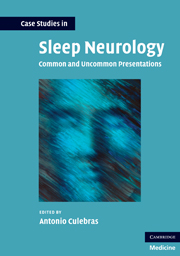
- Publisher:
- Cambridge University Press
- Online publication date:
- November 2010
- Print publication year:
- 2010
- Online ISBN:
- 9780511902505

Sleep disorders are increasingly recognized as a major clinical problem, with significant morbidity and considerable economic importance. This compendium of case studies presents a diverse range of situations which challenge the problem-solving abilities of all those interested in sleep disorders, covering both common and unusual cases. Each case begins with a clinical history, followed by examination findings and special investigations and culminating in diagnosis, treatment and management, with discussion of differential diagnosis where appropriate. Focusing attention on the major categories of sleep medicine, including insomnia, hypersomnias, sleep-breathing disorders, parasomnias, movement disorders, circadian dysrhythmias and the neurology of sleep, this clinical guide promotes integrative thinking and diagnostic skill. Historical and review citations, illustrations and concise real-life stories stimulate memory and facilitate learning. Written and edited by an international cadre of sleep professionals, this book will inform and challenge established specialists and provide a stimulating teaching tool for those in training.
 Loading metrics...
Loading metrics...
* Views captured on Cambridge Core between #date#. This data will be updated every 24 hours.
Usage data cannot currently be displayed.